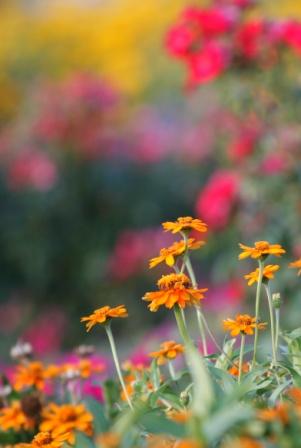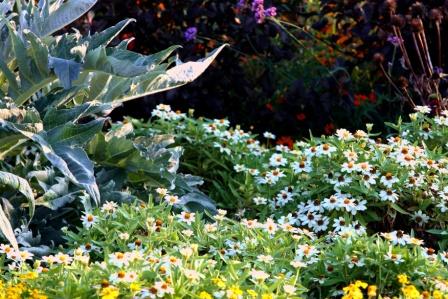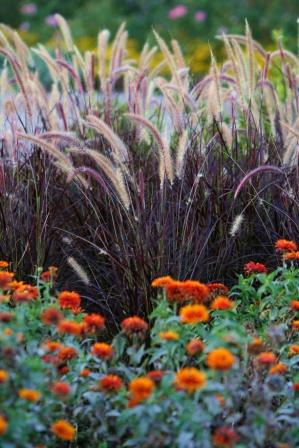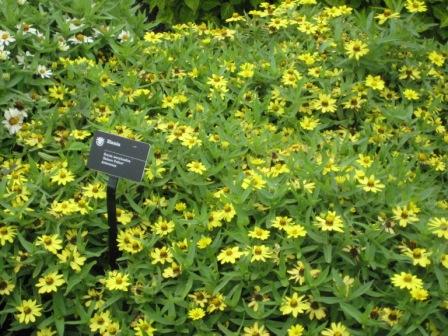
Zinnia elegans 'Uproar Rose'
Twenty-five years ago, as an adolescent, I developed an unexpected friendship with an elderly woman who lived down the street. Mabel Hart Crooks had an elaborate yard, filled with beautiful blooming plants. She was in her mid 90’s and needed some help with maintenance- mowing, weeding, pruning and occasionally planting. I was 13 and wanted the money! I credit her with sparking my interest in plants and gardening.
I recall my first experience sowing annuals from seed was under Mrs. Crooks’ supervision. They were zinnias, April’s GGW Plant Pick of the Month.
The popular dahlia-flowered zinnias Mrs. Crooks and I grew were introduced in the 1920’s. However, Zinnia elegans, the most well known of the 20+ species in the genus, was first hybridized in the 1700’s by European plant breeders. They successfully transformed the dull, purplish wildflower into brightly colored double forms. Today, zinnias are available in single, double and semi-double flower forms, range in size from dwarf, intermediate to tall, and are available in every color but blue.
Zinnias are native to Mexico and Central America and require rich, loamy, well-drained soil and full sun. They are drought tolerant once established, preferring hot and dry weather. So don’t overwater!
Many cultivars are prone to powdery mildew. I recommend thinning seedlings or spacing bedding plants to allow for good air circulation, and trying to avoid overhead watering.

Zinnia angustifolia x elegans 'Profusion Orange'
Better disease resistance has been developed by crossing Z. elegans and Z. angustifolia, resulting in Zinnia angustifolia x elegans. Several cultivars of this hybrid are All-America Selection (AAS) award winners, including ‘Profusion White’, ‘Profusion Orange’ and ‘Profusion Cherry’.

Zinnia angustifolia x elegans 'Profusion White'
I can tell you from personal experience, the ‘Profusion’ series zinnias are non-stop performers. I enjoy massing the dainty plants around bold architectural foliage, such as that of cardoon (Cynara cardunculus) and elephant ears (Colocasia ‘Illustris’). I also like to play with height variation by interplanting masses of ‘Profusion White’ with vervain (Verbena bonariensis).

Zinnia elegans 'Zowie! Yellow Flame' with Pennisetum setaceum 'Rubrum'
Mrs. Crooks would have loved the 2005 introduction Zinnia elegans ‘Zowie! Yellow Flame’, another AAS award winner. ‘Zowie! Yellow Flame’ has a unique bicolor pattern with magenta-pink centers and yellow petal edges. It is stunning when paired with Pennisetum setaceum ‘Rubrum’ or Salvia farinacea ‘Evolution’. Cut flower trials at the University of Maryland found that ‘Zowie! Yellow Flame’ had a vaselife of up to two weeks!
One of my favorite zinnias is ‘Uproar Rose’ (first photo at the top of the post). The 36″ tall plants produce massive 4″ to 5″ wide magenta flowers. ‘Uproar Rose’, like all zinnias, attracts butterflies to the garden. Do you have a favorite cultivar?

Zinnia marylandica 'Zahara Yellow'
Last year I came across Zinnia marylandica ‘Zahara Yellow’ at the Missouri Botanical Garden in the Lois Whiteside Franklin Flower Trial Garden. I like the soft yellow color and intend to grow it this year. Have you trialed a new cultivar our readers should know about?
If this is your first time visiting GGW Plant Pick of the Month and you’d like to participate, simply post your comments below and a link to your own site where you’ve posted photos of zinnias and comments about your experiences working with the plant, successful planting combinations, etc.
